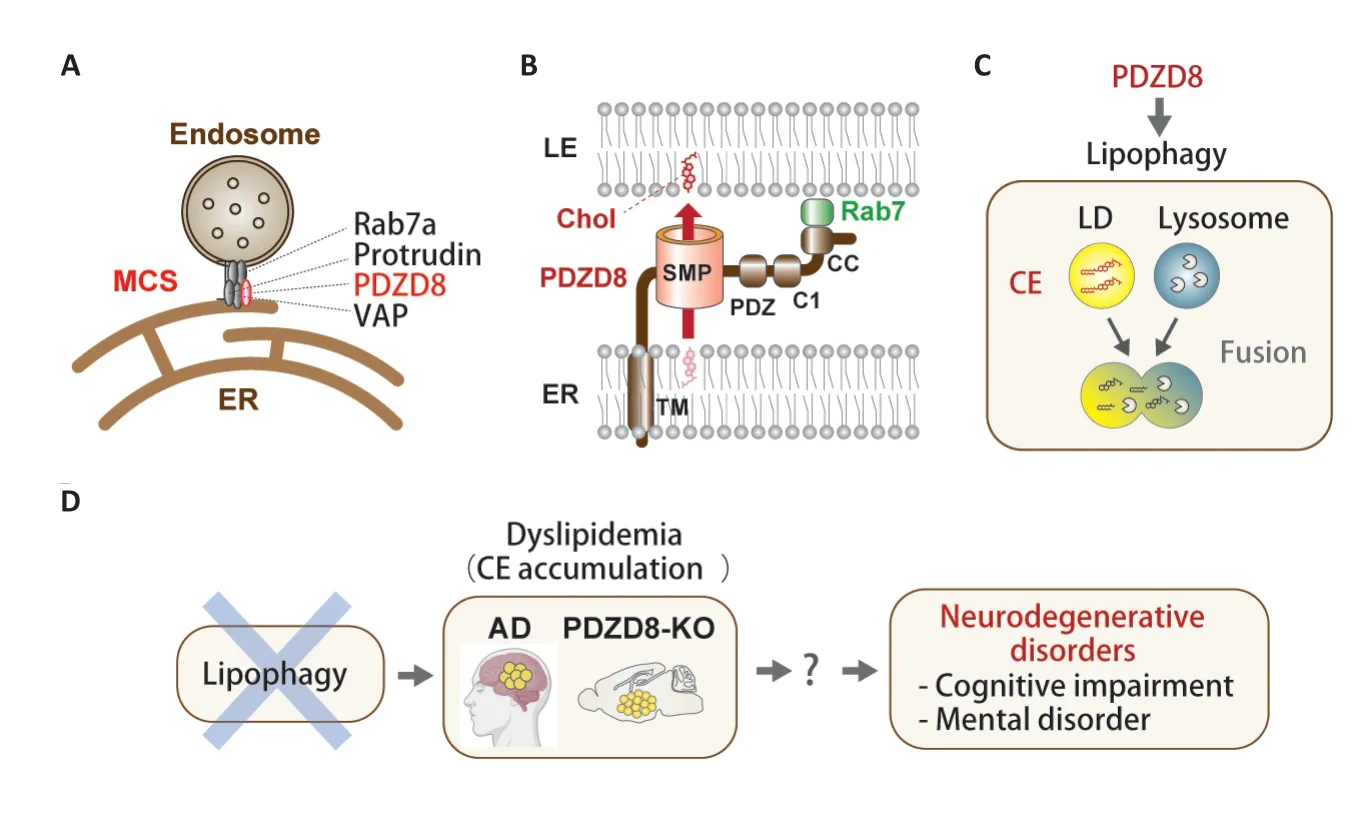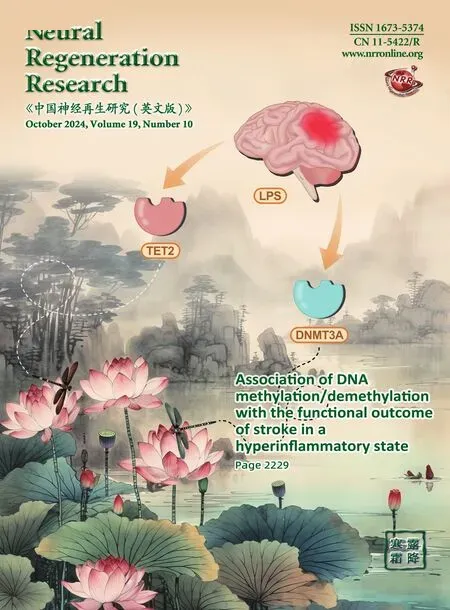Pathogenic contribution of cholesteryl ester accumulation in the brain to neurodegenerative disorders
Michiko Shirane
Cholesteryl esters (CEs) have been increasingly implicated in neurodegenerative disorders such as Alzheimer’s disease (AD).Alois Alzheimer noted three prominent neuropathologic features in his original analysis of the AD brain:senile plaques,neurofibrillary tangles,and lipid granule accumulation.Senile plaques,which are aggregates of amyloid-beta (Aβ),and neurofibrillary tangles,which are aggregates of phosphorylated tau,have been regarded as more consistent characteristics of the AD brain compared with lipid granule accumulation and thus have been studied more intensively (Foley,2010).However,more recent large-scale genetic studies have revealed that a major risk factor for late-onset AD (LOAD) is theAPOE4variant allele of the gene for apolipoprotein E (APOE),a protein that plays an important role in cholesterol metabolism and lipid transport.In addition,individuals who harbor variants of the gene for triggering receptor expressed on myeloid cells 2(TREM2),an immune receptor protein expressed in microglia,have also been known to be at higher risk for the development of LOAD.Such findings have led to an increased focus on defective lipid metabolism and inflammation in the brain as potential pathological mechanisms of LOAD (Shi and Holtzman,2018).The accumulation of CEs has also recently been identified in postmortem brain tissue of individuals with LOAD as well as in the brain of AD model mice,such as those that overexpress the Aβ precursor protein (APP) or which are deficient in APOE or TREM2 (Chan et al.,2012;Nugent et al.,2020).Furthermore,the accumulation of phosphorylated tau as well as the release of Aβ was shown to be promoted by CEs in neurons that were derived from induced pluripotent stem cells of individuals with AD and which harbored an extra copy of theAPPgene (van der Kant et al.,2019).CEs are highly hydrophobic lipids and are the main components of both high-density lipoprotein (HDL) outside of cells and lipid droplets (LDs) within cells.Potential causes of CE accumulation in the AD brain include impairment of the clearance of phagocytosed cholesterol contained in myelin debris,as has been demonstrated in TREM2-deficient mice,as well as defective cholesterol transport in the brain,as has been shown in APOE-deficient mice (Nugent et al.,2020).
Interorganelle membrane contact sites(MCSs):Intracellular organelles do not function independently but rather communicate with each other,with contact points between organelles being known as MCSs (Shirane,2020).At such MCSs,organelle membranes are in close proximity to each other,with a separation distance of <30 nm,and this narrow gap serves as a site for direct molecular exchange.The well-established cellular functions of MCSs include lipid transport,calcium regulation,and control of organelle dynamics,and the associated tethering molecules and underlying mechanisms of such functions have received much recent attention.However,the physiological functions of MCSs in mammals as well as the relations between MCS dysfunction and human disease have remained unclear.We have identified protrudin as a protein that plays a central role at MCSs between the endoplasmic reticulum (ER)and late endosomes (LEs) as well as characterized the mechanism by which it regulates polarized endosomal transport via these MCSs (Shirane and Nakayama,2006;Matsuzaki et al.,2011).By proteomics analysis of MCSs between the ER and LEs,we identified PDZD8,VAP-A/B,and Rab7 in addition to protrudin as key components of the multiprotein complex that constitutes such sites (Matsuzaki et al.,2011;Shirane et al.,2020;Figure 1A).

Figure 1 |Relation of PDZD8-dependent cholesteryl ester (CE) metabolism to the pathology of neurodegenerative disorders.
Lipid transport by PDZD8:The mammalian protein PDZD8 possesses an ER transmembrane domain and a synaptotagmin-like mitochondrial lipid-binding protein (SMP) domain in its NH2-terminal region.The amino acid sequence of this SMP domain is highly similar to that of the SMP domain of the Mmm1 subunit of the yeast ER mitochondrial encounter structure(ERMES) complex (Hirabayashi et al.,2017).The ERMES complex tethers MCSs between the ER and mitochondria and promotes lipid transport between these organelle membranes,thereby playing an important role in phospholipid biosynthesis.Several components of the ERMES complex contribute to tethering at these MCSs,including the ER membrane protein Mmm1 as well as proteins such as Mdm10 and Mdm34 that localize to the mitochondrial membrane.Whereas mammalian homologs of Mdm10 and Mdm34 have not been identified,PDZD8 possesses a coiled-coil domain in its COOH-terminal region that directly interacts with the GTP-bound form of the GTPase Rab7 present in LEs.PDZD8 is therefore capable of tethering the ER and LEs through interaction with Rab7,and its domain structure suggests that it might function in lipid transport at ER-LE MCSs (Figure 1B).Indeed,we recently showed that PDZD8 mediates the transport of lipids including phosphatidylserine and cholesterol between the ER and LEs in a manner dependent on its SMP domain (Shirane et al.,2020;Morita et al.,2022).
PDZD8-dependent endosome maturation and neuronal integrity:Early endosomes,which contain extracellular components internalized by endocytosis,undergo maturation into LEs,during which process they form multivesicular bodies through the incorporation of cytoplasmic components into intraluminal vesicles.This process is accompanied by a decrease in the internal pH of the endosomes and their eventual conversion to or fusion with lysosomes.Endosomal maturation is therefore essentially a degradative process for intracellular molecules.PDZD8 promotes endosome maturation in a manner dependent on its SMP domain,indicating that lipid transport between the ER and LEs mediated by PDZD8 is essential for this process.Failure of endosomal maturation in neurons has been shown to give rise to abnormal neuronal polarity and degeneration of the axon.PDZD8 and endosome maturation dependent on its lipid transport activity are therefore required for the maintenance of neuronal integrity (Shirane et al.,2020).
CE accumulation in the brain of PDZD8 knockout mice:To investigate further the physiological function of PDZD8 in the nervous system,in which it is highly expressed,we generated PDZD8 knockout (KO) mice with the use of the CRISPRCas9 system and performed lipidome analysis of the brain.We found that the abundance of CEs was specifically increased in the brain of PDZD8 KO mice compared with wild-type (WT) mice (Morita et al.,2022).In contrast,no lipid abnormalities were apparent in the liver of the mutant animals examined as a control tissue.To examine whether brain lipid levels might be affected by diet,we fed mice a high-fat diet for 1 month before performing lipidome analysis.Whereas the amounts of CEs and triglycerides were markedly increased in the liver of both WT and PDZD8 KO mice fed the high-fat diet compared with corresponding mice maintained on a normal diet,the highfat diet had no effect on lipid levels in the brain of either WT or PDZD8 KO mice.These results are consistent with the fact that HDL transfer from blood plasma to the brain is blocked by the blood-brain barrier.The accumulation of CEs in the brain of PDZD8 KO mice was thus not attributable to increased uptake of HDL from the periphery,but rather to either increased synthesis or defective degradation of intracellular CEs within the brain.RNA-sequencing analysis revealed no abnormalities in gene expression related to cholesterol or CE synthesis pathways in the brain of the mutant mice,suggesting that the aberrant CE accumulation might be due to defective CE degradation.Intracellular CEs are contained within LDs and their degradation is dependent on lipophagy mediated by the fusion of LDs with lysosomes.Imaging analysis showed that LDs and lysosomes failed to fuse in neurons of the PDZD8 KO mouse brain as well as in PDZD8-depleted neuronal cell lines.In particular,LDs became enlarged and aggregated in such cell lines,suggestive of the failure of lipophagy as a result of PDZD8 deficiency.CE accumulation in the brain of PDZD8 KO mice was therefore determined to be attributable to impairment of lipophagy (Morita et al.,2022;Figure 1C).
Regulation of brain function by PDZD8:Given that the abnormal accumulation of CEs in the brain of PDZD8 KO mice was reminiscent of that apparent in AD model mice,we hypothesized that the PDZD8 mutant animals might show
CE accumulation and AD:Increasing evidence suggests that defects in the endolysosomal pathway are associated with AD (Chan et al.,2012).Intracellular CEs are usually stored in LDs,but they have also been detected in LEs in the brains of individuals with AD,suggestive of a traffic jam of lipid transport.PDZD8 possesses intracellular lipid transport activity,and CEs accumulate in the brain of PDZD8 KO mice,consistent with the notion that defective intracellular lipid transport gives rise to CE accumulation.Abnormal lipid accumulation can also promote amyloid formation,with accumulated lipids possibly serving as seeds of amyloid oligomerization.These various findings suggest that alleviation of traffic congestion in intracellular lipid transport may be one approach to the prevention or amelioration of AD (Figure 1D).
Conclusion:Risk factors for AD such as the APOE4 variant suggest that defects in lipid metabolism in the brain may contribute to the pathogenesis of AD.Abnormal accumulation of CEs has been detected in the brains of individuals with AD or of AD model mice as well as in neurons derived from induced pluripotent stem cells of AD patients.CEs are hydrophobic neutral lipids that are stored in the form of HDL or LDs.PDZD8 is an ER membrane protein that plays an important role at MCSs between the ER and other intracellular organelles including LEs.We detected abnormal accumulation of CEs in the brain due to defective lipophagy as well as both memory and emotional defects in PDZD8 KO mice.Mutations in the PDZD8 gene have also been identified in families affected by intellectual disability,suggesting that PDZD8 is essential for brain function in humans as well as in mice.Although the degenerative brain regions may differ between AD model mice and PDZD8 mutant mice,both may result from a common mechanism whereby CE accumulation leads to neuronal degeneration.Further characterization of the mechanisms by which CEs accumulate in neurons and affect brain function may shed light on the pathophysiology of neurodegenerative disorders including AD.
Michiko Shirane*
Department of Molecular Biology,Graduate School of Pharmaceutical Sciences,Nagoya City University,Nagoya,Japan
*Correspondence to:Michiko Shirane,PhD,shiram@phar.nagoya-cu.ac.jp.
https://orcid.org/0000-0002-8297-9245(Michiko Shirane)
Date of submission:October 9,2023
Date of decision:November 29,2023
Date of acceptance:December 5,2023
Date of web publication:January 8,2024 abnormalities of brain function.To investigate this notion,we performed a battery of behavioral tests with PDZD8 KO mice.These tests revealed multiple abnormalities including memory and emotional deficits in the mutant mice (Kurihara et al.,2023).Compared with WT mice,PDZD8 KO mice manifested a reduced growth rate,hyperactivity,decreased anxiety and fear,increased sensorimotor gating,as well as impaired cued fear-conditioning memory and working memory.Another group has identified mutations of the PDZD8 gene in multiple families affected by intellectual disability (Al-Amri et al.,2022).Furthermore,mice with a PDZD8 mutation similar to one of those in such families showed behavioral abnormalities,including impaired spatial memory,reduced anxiety,and decreased habituation,similar to those of our PDZD8 KO mice as well as manifested structural brain abnormalities suggestive of a brain developmental deficit.These various observations have thus suggested that PDZD8 plays an important role in brain function in both humans and mice.PDZD8 has also been shown to contribute to synaptic function through intracellular calcium regulation (Hirabayashi et al.,2017),but the relation between lipid regulation and calcium regulation by PDZD8 in neurons is unknown and warrants further investigation.
https://doi.org/10.4103/1673-5374.392878
How to cite this article:Shirane M(2024)Pathogenic contribution of cholesteryl ester accumulation in the brain to neurodegenerative disorders.Neural Regen Res 19(10):2099-2100.
Open access statement:This is an open access journal,and articles are distributed under the terms of the Creative Commons AttributionNonCommercial-ShareAlike 4.0 License,which allows others to remix,tweak,and build upon the work non-commercially,as long as appropriate credit is given and the new creations are licensed under the identical terms.
 中國(guó)神經(jīng)再生研究(英文版)2024年10期
中國(guó)神經(jīng)再生研究(英文版)2024年10期
- 中國(guó)神經(jīng)再生研究(英文版)的其它文章
- Modulation of p75 neurotrophin receptor mitigates brain damage following ischemic stroke in mice
- Conformational dynamics as an intrinsic determinant of prion protein misfolding and neurotoxicity
- Exploring the synergy of the eyebrain connection: neuromodulation approaches for neurodegenerative disorders through transcorneal electrical stimulation
- Cognition and movement in neurodegenerative disorders:a dynamic duo
- Probing the endoplasmic reticulummitochondria interaction in Alzheimer’s disease: searching far and wide
- Music as medicine for traumatic brain injury: a perspective on future research directions
